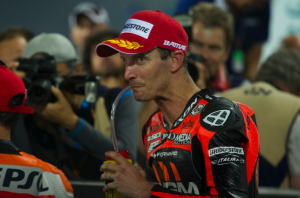Crisis kickstarts MotoGP into the future

JEREZ, Spain -- You could almost hear the sound of knees scraping asphalt, sparks flying, amidst the cacophony of engines roaring around the Jerez race track, during the final test day before the 2013 Motorcycle Gran Prix season begins at the start of April.As it was, the interview was almost drowned out by the sound of 25 bikes putting rubber to pavement at more than 300 kilometers (186 miles) per hour.
The roar of 25 bikes is good to hear, considering last year there were only 15, when the 65-year-old Grand Prix Motorcycle Championship, the series of 18 racing circuits with the world's top riders, was on the verge of shutting down. It was crushed by the crisis, suffering the continued loss of sponsorship and racing teams. Now, they are as big as ever. After evolving their rules and standards, instead of just featuring bikes with $50 million price tags, MotoGP is also now welcoming low-cost bikes to open the competition up to riders that could have never afforded to compete at this level otherwise.
While it seems like a dangerous, down and dirty sport -- and it really is -- MotoGP is also a really expensive one. Sure, Portuguese soccer star Cristiano Ronaldo may have the best cleats money can buy and travel around Europe with his entourage, but, even if he didn't have huge sponsors and a ridiculously lucrative paycheck, it doesn't cost that much to be a world-class soccer player. While teams dramatically vary, to race in MotoGP costs a lot, with some budgets reaching higher than $100 million. Even at 16, 18, 20 years old, these riders (and their parents, grandparents, local towns) may be paying at least part of the riders' and bikes' transportation costs to places like Malaysia, Qatar and Austin, Texas. Add to this their mechanics, managers and press folks, teams are moving around groups ranging from six all the way up to about 50 people, like for 79-win superstar Valentino Rossi.
The greatest expense is considered even more valuable than the rider himself -- the bike. Like the cars in Formula One, beyond being a display of speed and athleticism, MotoGP highlights cutting-edge technology that blog Asphalt and Rubber calls "rolling R&D platforms," with continual testing and tweaking, engine swapping, expensive hardware, and extremely light materials, like titanium. The research and investment that went into Rossi's bike alone is said to be around $50 million. Numbers like that -- until this year -- certainly made it nearly impossible for smaller, private teams to even have a chance. On the cusp of implosion, MotoGP had to become more sustainable by giving folks the ability to race on a smaller technical budget, but still at a competitive performance level.
While fans, especially in Spain and Italy, usually throw allegiance to the home countries of the racers, there are three types of teams in MotoGP: factory, satellite and, as of last year, Claiming Rule Teams (CRT).Both factory and satellite teams are sponsored by the bike manufacturers Honda, Yamaha and Ducati. Technically a team is composed of only one or two riders. However, the bike manufacturers have both factory teams, more closely linked with the manufacturer, and satellite teams, which have varying degrees of manufacturer influence.For these 12 riders on these six teams, the entire bikes are built on-site at the factories, with engineers and designers drawing on 30 to 40 years of research, development and experience in building winners. The factory and satellite bikes are collectively referred to as "prototype bikes" because, while these bikes will never go on the market, their research can eventually go into the production and sale of commercial bikes.
Finally, a third type of team -- the CRT -- grew out of crisis-fueled necessity. First, in 2007, advertising bans lost MotoGP its biggest sponsors -- the tobacco companies. Then, at the end of the 2011 season, what used to be the fourth factory and satellite sponsor, Suzuki, decided to drop out of the race completely. The loss of these four Suzuki racers,combined with the dropping out of other private teams that couldn't afford to compete anymore, brought MotoGP down from 25 riders in 2011 to 15 in 2012. This was the moment that could have marked the end for MotoGP.
Instead of accepting the downsizing or complete stalling of motorcycle racing as we know it, MotoGPgot innovative, welcoming onto the circuit the Claiming Rule Teams (CRTs), which have lower budgets and feature bikes not built in just a single factory. The main difference between the MotoGP prototypes and the CRTs -- besides that the first costs about five times the second -- is that while prototypes are produced as single packages in factories, CRTs are made of parts. CRT teams are able to build their bikes as they see fit, getting the engine from one company, a "chassis" or structure, and brakes from a third. Also, while CRTs are quick enough to compete in motorcycle racing's fastest competition, they aren't quite fast enough to beat out the factory bikes ... yet.
MotoGP and Madrid-based commercial and TV MotoGP rights holder Dorna, an international sports management firm, have also worked to adjust the rules and requirements to help bring CRTs up to speedbecause, after all, it's the thrill of the competition that sells tickets and sponsors. The CRT bikes have slightly larger fuel tanks, and, in an effort to quickly implement upgrades, the teams are able to change their engines 12 times in the season, double what the factory machines are allowed, in an effort to give CRTs an advantage to make faster upgrades. Since the engine is, of course, the most important part, the Italian maker of high-tech automotive parts Magneti Marelli and Dorna themselves are advising the teams' researchers, mechanics and engineers.

Vanessa Guerra is the press coordinator for the Switzerland-based Italian CRT team Forward Racing, which has grown from only a second-tier team in 2011, to now having two first-class MotoGP riders, as well as four second-class Moto2 riders, because of the new low-cost options. (While Moto2 bikes have less power than MotoGP ones, Moto2 riders start from a more level playing field because they are all required to use the same Honda engines.) The Forward Racing team includes rider Colin Edwards, who, last year, first CRT winner in MotoGP. This is an opportunity he couldn't have afforded if MotoGP's policies hadn't changed.
Guerra says her team has doubled because "the CRT concept has actually gotten more people interested, and, because more people are interested, more sponsors are knocking at our door and we are able to afford two riders." It's significantly easier to afford a spot for a logo on a CRT bike. If you are one of the top 5 ranked in MotoGP, like superstars Rossi or Jorge Lorenzo, sponsors are falling over themselves to get their brands on your bikes, helmets and leathers. Since the CRTs still remain out of that elusive quintet, sponsors can pay less and still get international visibility.
The design-your-own-bike concept, plus this year's expanded available resources, may seem like CRTs could have a competitive advantage, but Guerra warns that CRTs are still at a disadvantage since the teams don't have the same decades of engineering and design experience to back them up. While MotoGP prototype racers are reverently protective of every tiny aspect of their bikes -- even to the point that one prototype team has built up walls in the paddock between their own riders --sharing information across a CRT team can only serve to benefit the team as a whole. The much smaller teams are able to share R&D, at a level which they could never afford on their own. In Guerra's opinion, CRT teams don't have the luxury to be anything but collaborative. "You are already behind everyone else, you are just hurting yourself," if one team holds back information from another. "Obviously, in a team, your first competition is your teammate, but in CRT, you need to kind of support each other a little more because the more you help each other, the faster you are going to go."
Plus, when you have two riders on a collaborative team, you can split the testing between the two bikes, at least doubling your research.
In a move meant to give extra clout to CRT bikes, Factories are actually given the opportunity to "claim" or buy the CRT engines for 15,000 euros at the end of a race, which they can use to contribute to their own research. Of course, most MotoGP aficionadosdon't think that will happen, since doing so would essentially be an admission by the bigwig engine companies that they have a lot to learn from these little up-and-comers.
The introduction of CRTs is not all about pricing, but how to make the bikes competitive. MotoGP is notorious for having the top five or six riders always competing for those top five or six spots, with the private teams trailing too far behind to dream of catching up. But, looking at last week's final Jerez test results, no team seems too far behind. Twelve out of the 25 bikes competing this season are CRTs. The top CRT rider, while still in 12th place, was only 2.46 seconds behind frontrunner Cal Crutchlow. Last year, Guerra says, the gap was 3-, 4- or even 4.5-seconds. Of course, according to one columnist for Motor Sport Magazine, if you put Spanish stars Dani Pedrosa or Lorenzo on the seat of a CRT bike, that gap might close down to half a second. Plus, the season's just starting. Since engines are considered outdated or even obsolete after only two races, there's a distinct possibility that difference will narrow even more.
The season kicks off April 4th through 7th in Qatar. We will see by the season's end in November if CRTs can give the factory bikes a run for their money.
Photos: Forward Racing
This post was originally published on Smartplanet.com
